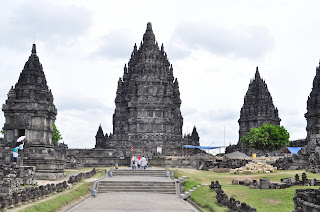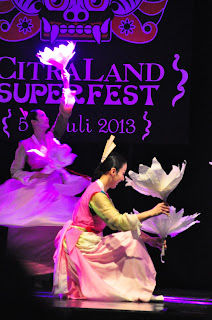I spent my Independence Day in a very different manner from
most other Americans. On the other hand, one could say I followed a long held
American tradition of getting deeply involved in something that I don’t
properly understand. Instead of barbecuing and drinking, I performed an East
Javanese dance in front of a few hundred people at Surabaya’s city hall. This
was the culmination of Tydif’s first month’s efforts for our program:
Surabaya’s Cross Culture Festival.
 |
| Our final rehearsal |
 |
| Photos courtesy of Leny, one of our photographers |
 |
| Success comes from not taking things too seriously |
Professional groups from around Indonesia, as well as China,
South Korea and India performed traditional dances and music from their homes
into which they clearly had put hundreds of hours and months of training. We,
however, went on stage with three weeks’ instruction, and only our Fijian
participant had participated in a choreographed dance before. Considering the
circumstances, I’d say we did pretty well.
The dance’s name is “jaranan”
which is Javanese for horse dance. Five of us, all three guys and the two tall
women, performed this one. While the moves were not very technically difficult,
we still struggled to memorize the whole five minutes. I retained most of the
routine, so somehow the group ended up following my lead. In the theme of
unexpected events, I bet none of you would have thought I’d lead a group in
dancing.
 |
| Our stage |
 |
| Stage Makeup: It took 3 days to get off |
 |
| Credit: Leny |
 |
| Scary (credit: Leny) |
 |
| The rest of these taken on my camera by Kezi, another instructor |
 |
| With our beautiful instructors |
 |
| Last minute recap of the moves |
 |
| Our heroes prepare for battle |
Of course, I had only remembered most of the dance, so towards the end, after excessive galloping
with our wicker horses, I forgot what followed, and paused. Then the other four
paused, staring at me, waiting to know what happened next. Remembering my piano
performances in the past, the worst thing we could have done was stop, so I
restarted with the final move, and had us repeat until the end. Somehow we got
back onto the beat with a short enough pause that most people probably didn’t
notice.
After so much stress leading up to the Cross Culture
Festival, the performance was cathartic, and I felt proud of us for learning so
much in such a short amount of time. Finally there was something, in some form,
to show for our time thus far in Surabaya.
On Friday, the remaining girls performed “Sparkling Surabaya”
which is a contemporary adaptation of traditional dances meant to portray the
classiness of Surabayan women. While the jaranan
required a lot of physical effort, the girls’ Sparkling Surabaya was
significantly more complicated to do right. They had a much steeper learning
curve and more to learn than we did, so their performance was even more
impressive. What’s more, they had tight corsets and wings. Go them.
 |
| Closeup (photos taken by myself again) |
Saturday was our music performance. This one is not as much
a point of pride. While we trained for a few hours almost every day in dance,
we only had five lessons for music. As a result, even the simple song we had to
present was fairly mediocre. I even felt slightly embarrassed going up on stage
with such little preparation, especially since we had pushed for more music
lessons in the beginning of the program. We did well enough, but certainly did
not reach our potential, and, as a musician, I was far from satisfied with the
outcome compared to what we could have accomplished. Our final performance at
the end of the program will be better though.
Following Cross Culture, we thankfully had a break for the
first part of this week. I took the opportunity to see another part of
Indonesia and headed to Yogyakarta, colloquially known as Jogja, in Central
Java. It was a necessary, albeit short, break from the noise and smog of
Surabaya.
What fascinated me most about Jogja was the fact that one
can actually walk around there. It’s
next to impossible around here, so I spent most of my time on foot, simply
because I could. This is largely because Jogja is a small, artsy, college city
while Surabaya is a large business and transit hub. Consequently, what
fascinated me after pedestrian friendliness was that at night it’s quiet. I could hardly get over it the
first night, as I lay in bed listening to nothing.
 |
| Quiet alleys filled with street art |
 |
| Surrounded by color in Jogja |
Furthering the tranquility, I spent one morning exploring
Prambanan, one of the largest Hindu temple complexes in Southeast Asia. Despite
being a UNESCO World Heritage Site, there were surprisingly few people at the
site. This meant that I got to explore the ancient temples entirely
undisturbed, listening only to a chorus of birds accompanied by faint gamelan music streaming from distant
speakers.
 |
| Suspicious bridge I found in the park |
While foregoing most other touristy things (such as
Borobudur, a huge Buddhist temple), I explored the Jogja food scene, because there’s
no better way to travel. There is fantastic street food, with locals crowding
most of the warung(wah-roong; food
stalls), while none in Surabaya appear to be particularly appealing. Gudeg(goo-duhg), consisting of jackfruit
boiled with coconut milk and palm sugar, is a ubiquitous traditional dish at
almost every warung. I made sure to
indulge in some of this, as well as sweet tea, which is even more prevalent
than the gudeg.
Most of my spending went to one artistic café that a friend
from the Surabaya group found the day before I arrived. I couldn’t resist
overindulging, especially in the abundant options for tropical fruits, reveling
in banana coconut pancakes and a fruit salad covered in Javanese chocolate and
peanuts. My favorite meal, however, was, while meeting up with the IACS
participants living in Jogja, we ate curried and fried cobra and python. It was delicious, although incredibly bony.
Eating a vertebrae’s worth of meat was a major project, but a rewarding endeavor.
 |
| Fried |
 |
| Curried |
During this period of
self-indulgence, the Muslim holiday of Ramadan began, a major aspect of which
is fasting from sunrise to sunset. The purpose of this is reflection on what is
important in life, as well as a practice in temperance, physically and
emotionally. People must restrain their anger as well as refrain from food or
drink for 11 hours a day. Since about 90% of the Surabayan population,
including the Tydif crew, is partaking, and I am here to learn from Indonesian
culture, I have decided to fast as well.
Yesterday was my first day of participating, with our Moroccan
participant excitedly waking me up at 3:30 in the morning for sahur, a kind of pre-dawn breakfast
before fasting begins at the end of the first prayer of the day. Najat (the
Moroccan) was very excited to share this experience with other participants (three
others tried it out as well), so she woke up earlier to cook a fairly extensive
meal for us. After shaking off the sleep and realizing I only had half an hour
left to eat, I made sure to stuff as much food as possible into my stomach to
hold myself until sundown. When the call to prayer ended at 4:00, it was all
over, and I had to wait until 5:30 that evening to eat again.
Somehow, I survived! What was most difficult was that, upon
feeling hungry, I had to resist the impulse to simply pick up the food nearby,
and wait. Also, some very intense cravings surged through my body at certain
points, specifically a desire for coffee and hamburgers, which led me to think
about Mom’s home cooked meals. That was particularly rough. I managed to
distract myself from the hunger for most of the day though, especially towards
the end when the dance instructors forced me to speak to them only in
Indonesian. It took so much brain power that there was no room to think about
food. Plus, I got some great language practice in (and they said I’m doing
well, which may or may not be true).
Finally, at 5:30, with the call to prayer, we all rushed the
refrigerator for tea and water, and the Tydif director brought us some treats
as well as icy coconut water. Now I really know to appreciate food and how
readily available it is to me. This had always been in the back of my mind, but
now it is right up front. Even though this is a decision, just for experience,
which I can stop at any point, it still reminds me of how so many people don’t
actually have a choice for something like this, and can’t run for food at a set
time.
Spending so much time with the Tydif team for our
performances (about twelve hours a day) was a great bonding experience. They could
share their passion with us by directly engaging us in how they live all the
time. Following the performances, I finally
found rest and reflection which provided a few revelations. While this is far
from the situation I expected or desired I am learning a lot about myself and
about people. It is a true challenge to work through, and a real test at
adaptation, as well as my philosophy of embracing the chaos, which is certainly
prevalent here. These experiences have helped solidify my resolve to make the
most of what has been presented to me. This part of life where I have ended up
is the perfect chance to create something beautiful, and whatever it may be, I will
make sure to fulfill the potential that it has created.
Here are some pictures of the other dancers from the festival:







































No comments:
Post a Comment